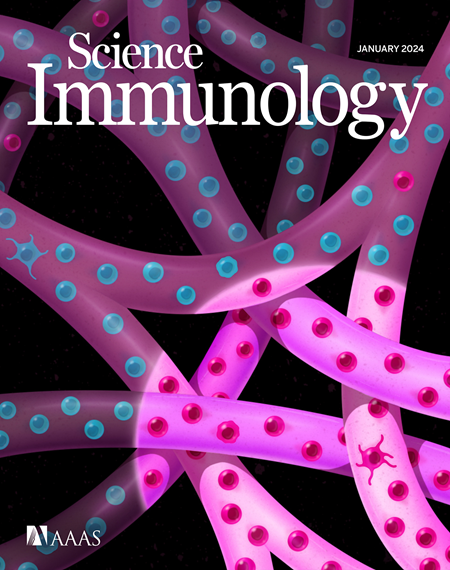埃及伊蚊唾液免疫抑制因子以人类 CD47 检查点为靶点,增强了虫媒病毒的皮肤传染性。
IF 17.6
1区 医学
Q1 IMMUNOLOGY
引用次数: 0
摘要
埃及伊蚊是包括寨卡病毒等黄病毒在内的多种传染性病原体的传播媒介。蚊子唾液中的成分会对脊椎动物宿主产生多形性影响,从而增强吸血能力,这些变化也为病原体的复制和传播创造了有利的环境。在这里,我们证明了已知参与各种免疫过程的人类 CD47 与一种名为 Nest1 的 34 千道尔顿蚊子唾液蛋白相互作用。Nest1 在吸血的雌性埃及姬蚊中上调,并促进寨卡病毒在人类皮肤外植体中的传播。与天然配体信号调节蛋白α相比,Nest1对CD47的亲和力更强,可在同一界面竞争结合。Nest1 与 CD47 的相互作用抑制了人类巨噬细胞的吞噬作用,抑制了白细胞的促炎反应,从而抑制了皮肤的抗病毒反应。这种相互作用阐明了节肢动物蛋白如何改变人类的反应以促进虫媒病毒的感染性。本文章由计算机程序翻译,如有差异,请以英文原文为准。
The human CD47 checkpoint is targeted by an immunosuppressive Aedes aegypti salivary factor to enhance arboviral skin infectivity
The Aedes aegypti mosquito is a vector of many infectious agents, including flaviviruses such as Zika virus. Components of mosquito saliva have pleomorphic effects on the vertebrate host to enhance blood feeding, and these changes also create a favorable niche for pathogen replication and dissemination. Here, we demonstrate that human CD47, which is known to be involved in various immune processes, interacts with a 34-kilodalton mosquito salivary protein named Nest1. Nest1 is up-regulated in blood-fed female A. aegypti and facilitates Zika virus dissemination in human skin explants. Nest1 has a stronger affinity for CD47 than its natural ligand, signal regulatory protein α, competing for binding at the same interface. The interaction between Nest1 with CD47 suppresses phagocytosis by human macrophages and inhibits proinflammatory responses by white blood cells, thereby suppressing antiviral responses in the skin. This interaction elucidates how an arthropod protein alters the human response to promote arbovirus infectivity.
求助全文
通过发布文献求助,成功后即可免费获取论文全文。
去求助
来源期刊

Science Immunology
Immunology and Microbiology-Immunology
CiteScore
32.90
自引率
2.00%
发文量
183
期刊介绍:
Science Immunology is a peer-reviewed journal that publishes original research articles in the field of immunology. The journal encourages the submission of research findings from all areas of immunology, including studies on innate and adaptive immunity, immune cell development and differentiation, immunogenomics, systems immunology, structural immunology, antigen presentation, immunometabolism, and mucosal immunology. Additionally, the journal covers research on immune contributions to health and disease, such as host defense, inflammation, cancer immunology, autoimmunity, allergy, transplantation, and immunodeficiency. Science Immunology maintains the same high-quality standard as other journals in the Science family and aims to facilitate understanding of the immune system by showcasing innovative advances in immunology research from all organisms and model systems, including humans.
 求助内容:
求助内容: 应助结果提醒方式:
应助结果提醒方式:


